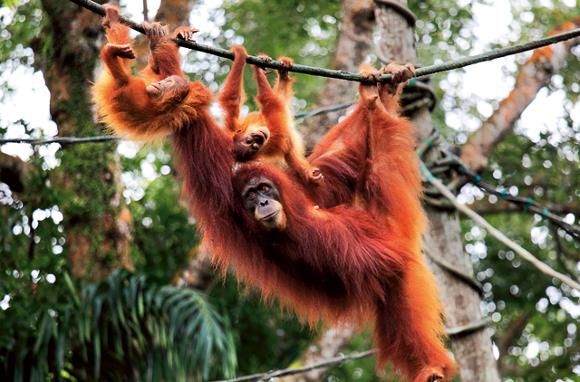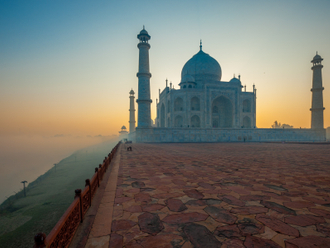
Never stand between a male and female orangutan.” The words hung precariously in the moist air. To our left the female orangutan clung to the tangled liana vines, eyeing the male to our right suspiciously. “Take a few steps backwards,” our guide whispered, as the group slowly but assuredly followed his instructions.
Tom, the alpha male with his telltale testosterone-fuelled cheek pads (the bigger the more dominant), stood on his hind legs mere metres away, one long arm dangling at his side and the other wrapped around a tree trunk supporting his huge, hairy frame. At 1.5m high, approximately 120kg and with four times the strength of a human, the group wasn’t taking any chances of coming between him and his latest love interest.
However, true to the orangutan’s gentle nature, Tom simply ambled past uninterested, his giant knuckles supporting his mighty weight.
Pausing again to lean lazily against another tree further up the wooded path, the King of the Apes glanced backwards, eyeing the little group of camera-clutching tourists to which the Camp Leakey orangutans have become so accustomed.
This is the Tanjung Puting National Park on the Sekonyer River in Central Kalimantan, part of the Indonesian side of Borneo. It is the third-largest island in the world and home to a dwindling population of orangutans. The Red Apes – as they are sometimes referred to due to their long, shaggy, reddish brown manes – can today be found only in the rainforests of Borneo and Sumatra, and consequently both places hold a unique draw for any tourist who wants to see and save the endangered species.
Over the past century these great apes – which share 97 per cent of our DNA – have had 91 per cent of their population decimated, and experts estimate they may be extinct within 25 years.
The primary reason for this depletion is loss of habitat, and here in the National Park, conservation efforts are being made to ensure their survival. The 300,000 hectares of protected rainforest enable more than 5,000 orangutans to live in a semi-wild environment where they can go about their daily foraging, nest-building and breeding without fear of plantation expansion, poaching, logging, forest fires or capture for the illegal pet trade.
It is the only protected area in South East Asia with vast tracts of wetland, lowland, mature tropical heaths and forest swamps. Here orangutans, along with proboscis and macaque monkeys, can feed from more than 400 species of tree, and take advantage of the care that they receive from the park wardens.
Being one of the last places on earth where orangutans exist in the wild, Central Kalimantan is a haven for conservationists, scientists, zoologists and eco-tourists. Vast, remote and beautiful, it is as romantic as it is educational. The unbroken soundtrack of the jungle as your traditional klotok riverboat chugs upriver, rainforest trees on either side swaying in the breeze or under the weight of travelling monkeys, is a constant reminder of nature’s ever-depleting beauty and its dire need of rescue.
The draw of nature
Nature is the paramount lure to this part of the world, and although Indonesia’s tourism sector is established in Bali, Kalimantan remains relatively underdeveloped, a raw treasure of lush rainforest. Central Kalimantan’s attraction is orangutans, and the rainforest has only one hotel, the Rimba Ecolodge, which is accessible only by boat from the port in Kampai. Transfers may be arranged as part of a package direct through the hotel, and from the moment you begin your orangutan journey, your guide will give you a detailed summary of their plight and the work being carried out by conservationists to save them.
A package with Rimba, which is normally spread over three days and two nights either staying at the lodge or on the boat, encompasses visits to three Orangutan Foundation International (OFI) feeding sites along the Sekonyer River: Tanjung Harapan, Pondok Tanggui and Camp Leakey, where at different times in the day food is laid out for the park’s primates. At the first whiff of a meal, eager orangutan mothers carefully carrying their young appear overhead, swinging gracefully between trees and vines high above the rainforest floor.
Scaling down in mere moments, the arboreal creatures with their bottomless brown eyes glide past awestruck visitors, mischievous babies hanging around their mother’s necks. Some are greedier than others, and spring on to the wooden feeding deck, stuffing as many banana bunches under their arms as possible and – almost as a cunning afterthought – thrusting another 20 or so precariously between their teeth, beaming a proud toothy smile at delighted tourists before waddling away slowly.
Although conservationists disagree on how best to look after the dying breed – with some arguing that daily food handouts create a damaging dependency on humans – one thing remains certain: there is nowhere else for them to go. “Orangutans can’t stay forever in the centres, but people just don’t know where they should live,” explains Bustar Maitar, head of Greenpeace International’s Indonesia forest campaign. “At one point they should go back to their natural habitat, but where is that habitat?”
The sad answer is that most of that habitat has disappeared, swallowed up by bulldozers to pave the way for unsustainable agriculture such as logging and palm oil. This threat is all too evident as our wooden klotok chugs through the jungle, for behind the lush mangroves and abundant palm trees where butterflies glide and brightly coloured kingfishers swoop gracefully, vast areas of contrasting nothingness can occasionally be seen through the breaks in vegetation. These areas of deforestation, which lie starkly bare under the summer sun, have been stripped of their natural resources to make way for ever-encroaching palm oil plantations.
Over the past five years Indonesia has seen a huge expansion in palm oil production, becoming the world’s largest producer. Driven by a surge in global demand and a positive impact on the Indonesian economy, millions of hectares of rainforest have been razed, simultaneously destroying the natural habitat of the endangered orangutan and many other species. Many orangutans also die in the deforestation process itself – either too slow to escape the manmade clearance fires, trapped in small clumps of isolated forest between vast, open plantations where they starve to death, or falling prey to palm oil farmers who shoot the ‘pests’ for eating their crops.
In Tanjung Puting National Park, many of the orangutans have been rescued and rehabilitated thanks to the dedication of charitable foundations, notably by the pioneering primatologist Dr Birutė Galdikas and her charity Orangutan Foundation International.
In 1971 under the auspices of famed palaeontologist Louis Leakey, scientist and conservationist Galdikas moved to Tanjung Puting to observe the species in their natural habitat and look after baby orangutans orphaned by illegal logging.
Thanks to Galdikas’ prolific studies, much is now understood about the orangutan; they laugh when tickled, complain when hungry and cry when hurt. One of the orangutans at Camp Leakey, Rinnie, was even able to learn sign language – although she promptly lost interest when she realised that her human teacher, a student named Gary Shapiro, was not interested in her advances.
The forest is alive
Camp Leakey is the world’s principle orangutan research centre, and trekking through the humid forest walkways with intertwining roots cutting across pathways, the sounds of crickets and cicadas heavy in the air, you stand a good chance of seeing well-nurtured orangutans swinging past you from the jungle vines or step on to the path simply to hang from a trunk, blinking, watching, scratching.
Mothers may clamber past, carrying a baby on their back and turning around curiously to watch you. Others walk past on their hind legs, baby by their side, arms around one another as they walk off into the forest to prepare their nightly nests way up in the top of forest trees.
Dusk is a exceptional time in the rainforests of Kalimantan, alive with the sounds of primates rustling through the trees, collecting leaves to make their beds, while those who cannot see in the night busy themselves as the sun goes down.
Tourists must leave the park before nightfall and the klotok journey back down the clear Black River (this is the only part of the Sekonyer that has not been muddied by years of gold mining) is a heart-wrenching moment of clarity for why this part of the world simply cannot be lost.
Slender macaque monkeys litter the tall, dense trees along the riverbed, while graceful hornbill birds fly past, their giant beaks silhouetted by the dying sun. Multicoloured butterflies flutter along the water, while the evening sky’s pink and golden hues reflect the forest on the widening waterway.
As our klotok chugs its way back to the basic but rustic Rimba Ecolodge, our tour guide scours the water’s edge for crocodiles, and as night falls the mangroves just beyond the hotel come to life, with fireflies twinkling against the backdrop of darkness, like nature’s very own Christmas tree. Nighttime on the riverboat is an opportunity to truly appreciate the beauty of one of the most remote places on earth, where myriad stars sparkle overhead and the Milky Way is a bright brushstroke across the midnight sky.
A lodge in the wild
The combination of illuminated fireflies fluttering in the trees and starry night overhead is the stuff honeymoons are made of – but if it’s a romantic break you’re after, be sure to ask for an air-conditioned room at the lodge and hot, running water, for this place serves more as a suitable base for orangutan enthusiasts and ecology trips than anything else.
Run by conservationists who care deeply about the local area, the Rimba employs local villagers, offering them alternatives to working in the plantations. Nearly all of the tour guides are former illegal loggers, who gladly accepted the rare opportunity of employment in the vicinity, allowing them to earn a decent salary while caring for the environment instead of destroying it.
The lodge, which sees tourists of all types throughout the year from the serious eco-traveller to the honeymooning couple, is set on a jetty off the Sekonyer River and is surrounded by nothing other than water and rainforest.
Wooden walkways separate the rooms from recreational areas, and although it’s no-frills, it works perfectly for its surroundings. It has been constructed in such a way that it doesn’t infringe upon nature, and lying in your room at night, aside from the noise of the fan overhead, there is no denying you are in the midst of nature’s wonder.
There is no phone signal or Wi-Fi – something most city slickers will abhor initially but should relish within 24 hours.
The menu offers locally grown ingredients in freshly prepared delicious Indonesian dishes at mealtimes – but be warned they like their spices! And when not at the lodge, the cuisine is also first-rate on the klotoks, where on-board chefs prepare excellent spreads, as the competition to be the top chef on the Sekonyer river is fierce.
The food served on the Rimba Princess klotok is prepared by the Eco lodge chef, so you can be sure it’s sustainably sourced as well as tasty. The management also has plans to work alongside the local deforestation foundation, Friends of the National Forest, who in an attempt to persuade villagers against selling their land to palm oil plantations, are offering incentives to raise cows and grow organic produce. The Rimba Lodge will be purchasing this to serve to guests.
These initiatives to educate the local community about the importance of maintaining and protecting the rainforest are vital in the fight against deforestation. The stunning scenery and wildlife are at risk of disappearing for ever. Across the globe an area of rainforest the size of a football pitch is destroyed every second, and Kalimantan has lost more than half of its lush, green woods already.
With orangutans only reproducing once every seven to eight years, giving birth to only one child each time, the consequences of this huge threat to their livelihood are clear. Their population grows very slowly, and even if given the chance, they will take a long time to recover.
As a tourist to one of the most remote areas left in the world, you will not be disappointed. Although somewhat stripped of luxuries, it is instead abundant with the beauty of nature and by visiting this faraway land of monkeys and fireflies, forest and macaques, tourists can help replace the lure of ill-practised palm oil production and illegal logging with sustainable tourism.
This is the kind of holiday where the sounds of the orangutans slipping through the rustling trees above as the insects hum will forever be etched into your memory.












